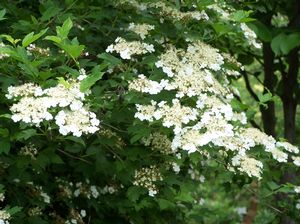Printed at http://www.quackingrassnursery.com/index.cfm/
Viburnum opulus
European Cranberrybush Viburnum
Plant Type:
DECIDUOUS SHRUBSViburnum opulus - Good, old-fashioned European Cranberrybush Viburnum is hard to beat for copious and persistent fruit. Showy drupes of bright red fruits, each berry about one-third in diameter ripen late season and persist right through the winter here. It seems that migrating birds, ravenous in late winter/early spring on their northward journey appreciate them only after having been bletted during the long winter. We've seen Cedar Waxwings, Robins and others denuding shrubs at this time, both heart warming and entertaining. Pretty white flattened lace caps up to 4 inches in diameter adorn the shrub aplenty in May. Maple-like leaves are attractive may turn a mix of yellow, red and/or purple in autumn but more often than not the leaves drop green. We're growing 4 plants - 2 on each side of an entrance to a garden where we will, when they achieve enough height, pull them together at the top to create a living arch. Plant in fertile, draining soil sited in full to half sun. Cutting grown.
Characteristics and Attributes for Viburnum opulus
Season of Interest (Flowering)
- Spring
Season of Interest (Foliage)
- Spring / Summer / into Autumn
Autumn Interest
- Autumn Leaf Color
- Fruit / Berries / Seed Heads
Nature Attraction
- Deer Resistant
- Butterflies
- Songbirds
- Honey Bees & Native Bees
Light
- Full Sun
- Mostly Sunny
Attributes
- Hedge
- Specimen
- Hedgerow
- Natural Garden
- Screen
- Wildlife Garden
- Shrub Border
Growth Rate in the Garden
- Moderately Fast
Soil
- Draining
- Fertile
Origins
- Asia
- Europe
- North Africa
Propagated By
- Cutting Grown
Genus Overview: Viburnum
Common Name: Viburnum
Viburnum. This genus is full of fantastic, multi-season garden worthy shrubs. Garden heroes. Spring flowers, often large and showy, many with heady sweet fragrance are arranged in cymes. Some smell of musk (Viburnum dilatatum) while others produce no fragrance at all. Flowers are followed with berries. If late season and autumn berries are desired then planting two of a species will ensure fruit set; for instance, Viburnum dilatatum 'Erie' and V. dilatatum 'Michael Dodge' will pollinate each other and produce fruit. Viburnum cassinoides is closely allied with V. nudum; but if the flowering times do not overlap then there will be no fruit. However, if you plant V. nudum 'Winterthur' in proximity with V. nudum var. angustifolium, 'Longwood', 'Moonshine' or 'Pink Beauty' berries will abound. Another interesting example is V. lantana which crosses with V. burejaeticum and vice versa. Any V. plicatum f. tomentosum selection such as 'Shasta' or 'Shoshoni' will pollinate with all other V. plicatum f. tomentosum selections like 'Copper Ridges or 'Pink Beauty'. But if you were to plant two 'Shasta' side by side with no other V. plicatum f. tomentosum in near proximity then your effort will be fruitless. As with almost all in the universe of plants there are exceptions. There is one viburnum which appears to be self-fruitful, Viburnum setigerum the Tea Viburnum. Another interesting exception to the rule is Viburnum nudum 'Pink Beauty' which is also self-fruitful - a departure from its siblings. And on the other spectrum are two I can think of off-hand that are barren, Viburnum plicatum 'Roseum' and Viburnum plicatum 'Kern's Pink'. Oftentimes, the dwarf viburnums reamin in a juvenile state and do not produce fruit. All Viburnum of any size that do produce fruit are magnificent in the late season garden. And they feed all manner of birds. Larger, denser shrubs provide cover and nesting opportunities. Nearly all Viburnum have terrific autumn foliage colors, too. Viburnums are members of Caprifoliaceae. All prefer part to full sun and fertile soils. All are cutting grown. Many thanks to Gary Ladman of Classic Viburnums who generously set us straight regarding some of the details we had originally incorrectly lauded... ya can't know everything!



